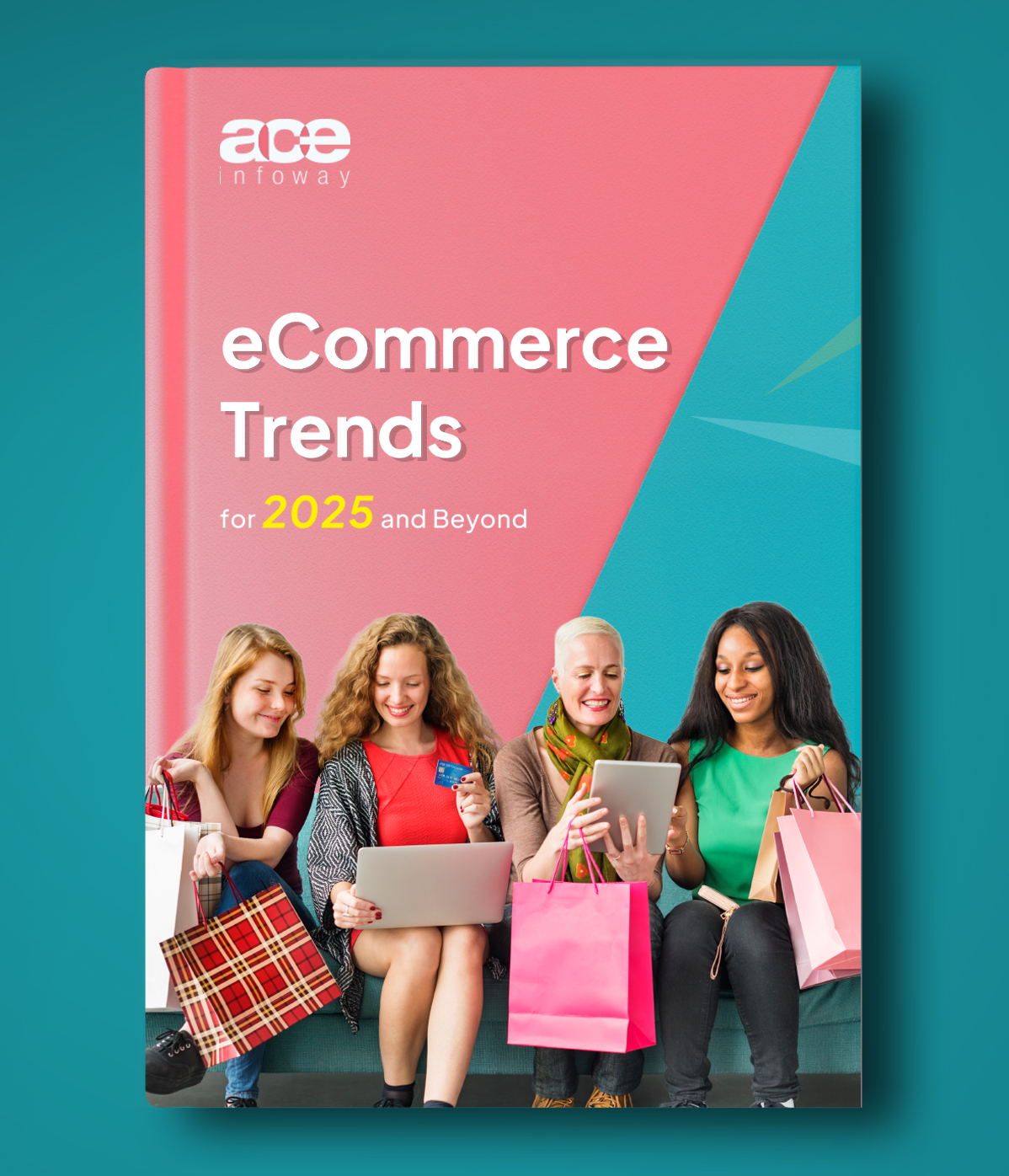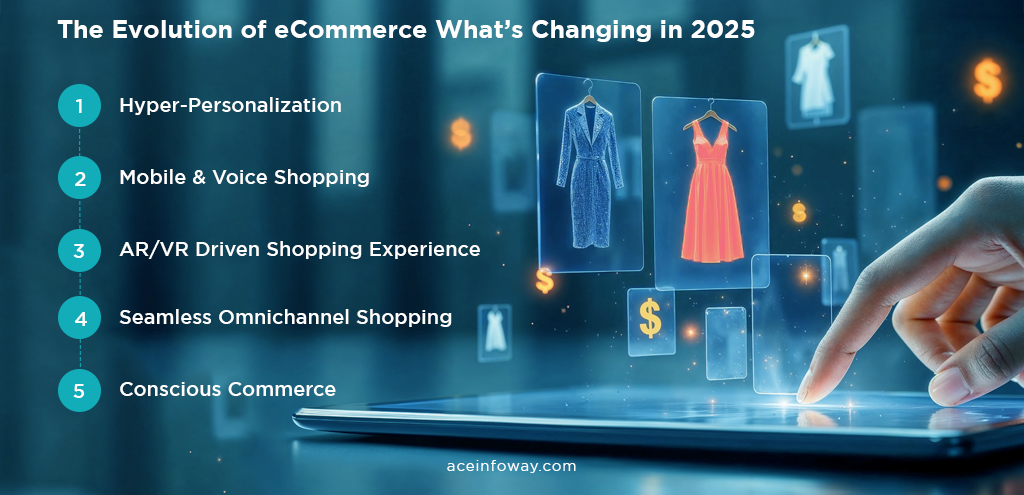Table of Contents
Ever since the digitization of trades- selling and buying on online platforms, it has significantly changed the way customers shop and businesses sell. eCommerce is a predominant way of doing business these days, holding as much importance as physical stores or even more than that. A report by Statista estimates retail eCommerce sales to exceed 4.3 trillion USD worldwide, and by 2027, it is expected that 22.6% of all retail purchases will be made online.
As we move deeper into the digital-first economy, eCommerce trends 2025 are reshaping the rules of eCommerce business, and those who fail to adapt may soon find themselves irrelevant. The way customers discover, evaluate, and purchase products is being redefined by rapid technological advances and shifting behaviors.
As an eCommerce business, if you’re still operating like it’s 2018—without personalization, mobile optimization, or social commerce—you’re already leaving revenue on the table. Worse, you’re risking long-term brand erosion.
If you are an enterprise, marketplace, or retailer that wants to remain competitive, innovative, and profitable in this high-speed digital economy, this blog is for you. More importantly, if you’re not already adapting, now is the time to act—and we can help you get there.
Why eCommerce Trends 2025 Are Business-Critical?
Every click, swipe, and purchase tells a story, and 2025’s eCommerce landscape is being shaped by new technology and changing consumer expectations. These aren’t optional upgrades—they are survival strategies.
Some of the most defining eCommerce trending shifts include:
- AI-powered personalization delivering real-time recommendations.
- Voice commerce is redefining how people shop hands-free.
- AR and VR are creating immersive buying experiences.
- Social commerce is turning platforms like TikTok and Instagram into full-scale marketplaces.
- Sustainability and ethical commerce influence purchasing decisions.
These features have become an integral as well as essential part of the retail industry trends that are actively shaping purchasing behavior.

eCommerce Trends 2025: AI Adoption and Modern Consumer Behaviour
Get your free copy
The Evolution of eCommerce: What’s Changing in 2025?
eCommerce in 2025 isn’t about keeping up—it’s about standing out. Consumer behavior is evolving at lightning speed, driven by technology, convenience, and rising expectations. Businesses that once thrived through static websites and basic product listings are now losing ground to brands that embrace innovation, automation, and personalization.
Understanding these eCommerce Trends 2025 isn’t just informative—it’s essential to your survival.
Below are the five biggest shifts transforming the digital commerce landscape today. These directly fuel the business consequences we explore in the next section, because not responding to these trends doesn’t mean staying the same; it means falling behind.

1) Hyper-Personalization
AI and machine learning allow brands to tailor everything—from product recommendations to homepage layouts to dynamic pricing. Consumers don’t just want personalization—they expect it. Brands not offering it risk losing conversions and customer trust. Businesses miss out on revenue from upsells, lose returning customers, and end up with generic experiences that feel irrelevant.
2) Mobile & Voice Shopping
With over 70% of online purchases coming from mobile devices, and billions using voice assistants like Alexa and Siri, shopping behaviors are becoming faster and more conversational. Optimizing for mobile and voice is no longer optional. High bounce rates, poor mobile conversions, and a lack of visibility in voice search results all lead to declining traffic and engagement.
3) AR/VR Driven Shopping Experience
Today’s buyers want to experience products before buying—whether it’s through AR fitting rooms, 360-degree product views, or video reviews. Visual, interactive content is the new standard. Reduced trust, higher product return rates, and less attention from shoppers who now expect immersive content across all platforms.
4) Seamless Omnichannel Shopping
Shoppers switch between devices, channels, and platforms during a single buying journey. Businesses that don’t unify their presence across websites, social media, apps, and marketplaces offer disjointed experiences—and lose customers in the process. Businesses experience cart abandonment, poor retention, and increased marketing spend as they try to recapture lost users.
5) Conscious Commerce
Today’s consumers care where their products come from, how they’re packaged, and what your brand stands for. Transparent supply chains, ethical practices, and sustainability messaging are influencing who they choose to buy from. eCommerce businesses can undergo loss of credibility, poor brand relevance, and failure to connect with new-age buyers who prioritize values as much as price.
The Cost and Disadvantages of Not Following eCommerce Trends 2025
Adopting eCommerce Trends 2025 isn’t just about staying trendy—it’s about staying in business. Inaction comes with steep costs that most businesses only realize when it’s too late. From lost customers and missed revenue to operational chaos and rising marketing expenses, the risks of ignoring the latest trends in the commerce industry are not theoretical—they’re already hurting businesses across industries.
Let’s break down the most damaging effects of falling behind, in clear terms and with real-world context.
Missed Revenue Opportunities
Every year you delay adopting new eCommerce innovations, you lose a growing percentage of potential revenue. Why? Because your competitors are giving your customers better experiences.
When brands fail to offer AI-driven recommendations, quick checkouts, or modern product displays, they leave money on the table. Customers today expect brands to “know” them—what they like, what they’re likely to buy next, and how they want to interact.
For example, a fashion retailer using AI personalization can have a significant increase in average order value after suggesting outfit bundles based on past purchases. Meanwhile, a competitor that still relied on basic category filters reported flat year-over-year sales despite increased ad spend.
Declining Customer Retention
Acquiring customers is hard. But losing them because of outdated shopping experiences is even worse. When businesses ignore eCommerce trending features like automated follow-ups, loyalty programs, and relevant product suggestions, customers stop coming back.
Modern consumers want a brand relationship that feels intuitive and rewarding. If your checkout is clunky, your product recommendations feel random, or you don’t acknowledge their preferences, they’ll go elsewhere—and fast.
Dropping Off Search & Social Algorithms
Search engines and social platforms are no longer just content discoverers—they’re shopping engines. Platforms like Google, TikTok, Instagram, and Pinterest are prioritizing video, interactivity, voice search, and rich media. If you’re not aligning with platform algorithms, you’re not just behind—you’re invisible.
If your product pages aren’t voice-optimized, your social media lacks shoppable features, or your content strategy hasn’t adapted to include reels, carousels, or live shopping, you’re becoming invisible.
Operational Inefficiencies Drain Time and Money
You might be surprised how many brands still manage inventory manually, handle customer inquiries through unconnected inboxes, and fulfill orders through disconnected systems. These outdated processes don’t just slow you down—they create errors that cost real money.
eCommerce Trends 2025 include intelligent automation, integrated CRMs, ERP systems, real-time analytics, and AI support bots—not just because they’re advanced, but because they save time, cut costs, and prevent expensive mistakes.
For example, you are relying on a manual or traditional method to manage inventory. Now, your limited-time discount offer went viral, and you oversold the trending items, which resulted in hundreds of refunds and negative reviews, causing long-term customer trust damage. Now, in such a case, having a tech-powered or AI-powered inventory tracking or management system would have prevented such a crisis.
Higher Customer Acquisition Costs (CAC)
If you’re not using smart tools to segment your audience, create tailored landing pages, and deliver contextual product suggestions, you’re spending more to get less. Paid ads alone aren’t enough to drive growth unless they’re paired with eCommerce trending strategies.
Customer acquisition costs are already rising due to platform saturation. If you’re relying on static ads and driving traffic to generic pages, you’re overpaying for every lead and converting fewer of them.
Brand Irrelevance in a Crowded Market
In today’s saturated eCommerce landscape, buyers have endless choices. That makes relevance and emotional connection more important than ever. Brands that don’t reflect modern values like sustainability, inclusivity, speed, and transparency will be passed over, even if they offer good products.
Retail industry trends now favor brands that are fast, visually appealing, data-driven, and ethically aligned. If your brand doesn’t reflect those values in 2025, you’ll start to feel the silence from your audience. Relevance is no longer about your product—it’s about the entire brand experience and values you project.

eCommerce Trends 2025: AI Adoption and Modern Consumer Behaviour
Get your free copy
Conclusion
Adapting and implementing eCommerce trends of 2025 is not just about innovation or making your eCommerce platform look modern; it’s about ensuring that your business stays visible, relevant, and profitable in today’s highly competitive digital landscape. The longer any eCommerce business resists change or modification, the more it costs, and many eCommerce businesses have already experienced it. Our eCommerce development services help make whatever seems complex simple- whether that’s a smarter eCommerce platform, a more efficient checkout process, or a full-scale digital transformation aligned with your unique goals. At Ace Infoway, we offer end-to-end eCommerce development services using cutting-edge technologies and the most advanced tools to keep your eCommerce business ahead of the curve and future-ready.

























